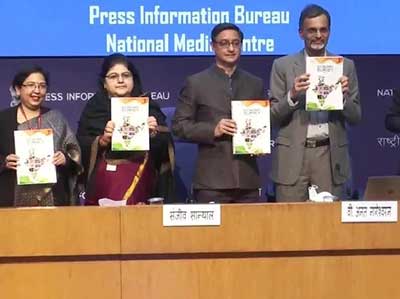Relevance: GS-3: Government policies and interventions for development in various sectors and issues arising out of their design and implementation; Inclusive growth and issues arising from it; Government Budgeting; Science and Technology- developments and their applications and effects in everyday life.
Key Phrases: Satellite data for policymaking, Satellite imagery, Geospatial data and Cartographic techniques, Resourcesat, night-time luminosity, land-use maps, tracking of natural disasters and pollution.
Why in News?
- A growing trend of using satellite data by policymakers in India has been highlighted in the Economic Survey 2021-22, underscoring the leaps in technology usage to draft policies and track longer-term socio-economic trends.
Key Points:
- The Economic Survey has used a mix of satellite imagery, geospatial data and cartographic techniques to showcase the country's development and urbanisation over the years.
- A new chapter, 'Tracking Development through Satellite Images and Cartography', demonstrates the use of satellite and geo-spatial images to gauge various economic phenomenon such as urbanisation, infrastructure, environmental impact and farming practices, among others.
Background:
- Globally, the use of such satellite data for policymaking and research has been increasing, as the survey itself pointed out. The increasing availability of such data has largely driven this.
- The pioneer in this space has been the NASA Landsat missions,
which have made such data available online and for free, giving researchers
and policymakers easy access to real-time data.
- This was followed by the European Space Agency’s Sentinel missions, and closer to home, the Indian Space Research Organisation’s own family of satellites such as Resourcesat.
- The extraordinary flexibility and range of the types of data
available from satellites is because of the way various substances and
materials such as a standing crop of wheat, a concrete building or a
polluted water body reflect light in some parts of the electromagnetic
spectrum while absorbing light in others.
- Satellite sensors can detect these differences, some of which are outside the visible light spectrum range, and this data can be synthesized and mapped, sometimes with a lag of a few hours to a few days.
Significance:
- The most striking of such maps are those of night-time luminosity.
These are essentially photographs of the earth at night, which show
areas of human habitation as brightly-lit specks caused by electric lights
against a dark background.
- Using satellite images, India's night-time luminosity has been compared between 2012 and 2021.
- The Survey noted that the Night-time luminosity provides an interesting representation of the expansion of electricity supply, the geographical distribution of population and economic activity, urban expansion as well as growth of ribbon developments between urban hubs.
- Related to this are land-use maps, which can differentiate
between areas of the earth covered by forests, crops and water bodies from
those covered by human settlements such as buildings.
- Such data helps municipalities track the spread of urbanization and the conversion of agricultural land to urban uses.
- Geospatial and cartographic techniques have been used to show the
extent of physical as well as financial infrastructure development in India.
- This includes expansion of national highways, airports, commercial bank branches, metros, etc.

Fig: India’s Night Time Luminosity in 2021 and 2012
- Another use case is in agriculture. Satellite data can allow
governments to track the progress of crop sowing through the agricultural
season.
- Comparing the progress of such sowing in a particular crop season with those in earlier years can allow governments to detect and predict a potential slowdown in agricultural growth.
- Another use case is the tracking of natural disasters such as flooding. The near real-time availability of satellite data can allow governments, NGOs and volunteers on the ground to track the spread of flooding or wildfires and plan the delivery of relief supplies to affected populations.
- It can also be used for pollution tracking.
- Because a more polluted water body reflects light differently than a less-polluted water body; these differences can be identified and can enable pollution agencies to locate areas of a waterbody that are less or more polluted.
- Similarly, air pollution and the density of particulate matter, too, can be tracked daily.
- While ground-level sensors can provide a picture of pollution levels at the scale of a city or neighbourhood, satellite data can track pollution levels at the scale of whole countries.
- A significant application of the satellite data is to identify locations where crop burning occurs during the winter months—a major source of air pollution in north India.
Way Forward:
- However, even satellite data can often not be used in its raw form—it needs to be processed by the end-user to get useful insights.
- It’s easy to get satellite imagery, but the true test is to be able to build the right algorithm for policy insights. India does have the infrastructure to build such algorithms.
- Hence, along with imagery, government should also focus on the modelling aspect.
Conclusion:
- When data changes, so does opinion; when data sources change, data streams become faster and real-time; the edifice of holding opinions should change too. This, the Survey argues with elegance.
Source: Live Mint
Mains Question:
Q. Economic Survey 2021-22 has given emphasis on the use of new forms of data and information for tracking economic activity and development. Discuss.







